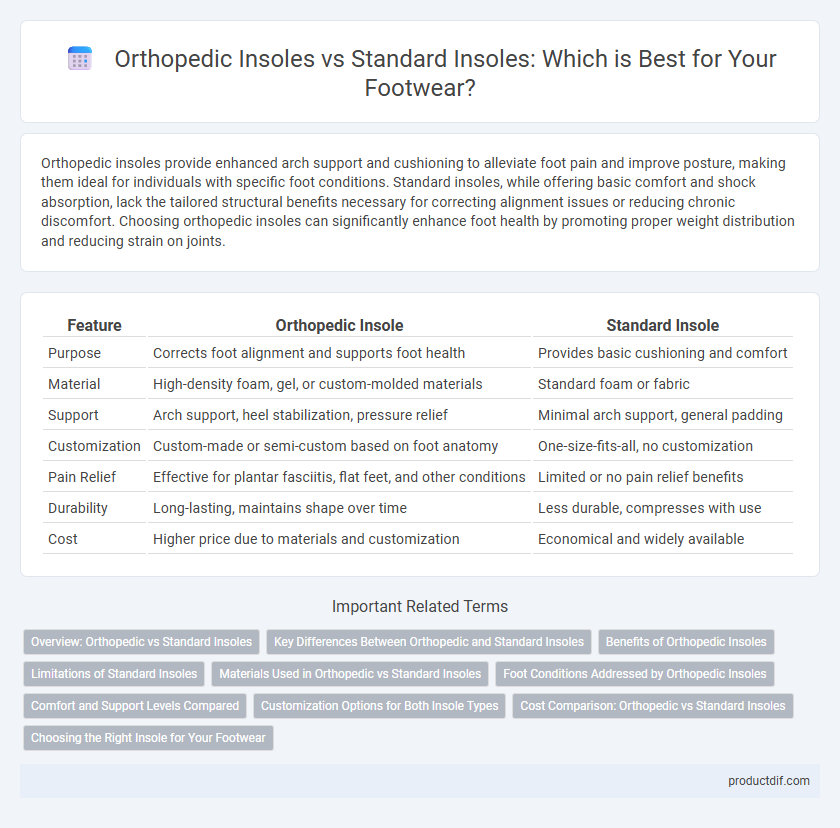Orthopedic insoles provide enhanced arch support and cushioning to alleviate foot pain and improve posture, making them ideal for individuals with specific foot conditions. Standard insoles, while offering basic comfort and shock absorption, lack the tailored structural benefits necessary for correcting alignment issues or reducing chronic discomfort. Choosing orthopedic insoles can significantly enhance foot health by promoting proper weight distribution and reducing strain on joints.
Table of Comparison
| Feature | Orthopedic Insole | Standard Insole |
|---|---|---|
| Purpose | Corrects foot alignment and supports foot health | Provides basic cushioning and comfort |
| Material | High-density foam, gel, or custom-molded materials | Standard foam or fabric |
| Support | Arch support, heel stabilization, pressure relief | Minimal arch support, general padding |
| Customization | Custom-made or semi-custom based on foot anatomy | One-size-fits-all, no customization |
| Pain Relief | Effective for plantar fasciitis, flat feet, and other conditions | Limited or no pain relief benefits |
| Durability | Long-lasting, maintains shape over time | Less durable, compresses with use |
| Cost | Higher price due to materials and customization | Economical and widely available |
Overview: Orthopedic vs Standard Insoles
Orthopedic insoles are designed to provide targeted support and correction for common foot issues such as plantar fasciitis, flat feet, and overpronation, using custom or anatomically shaped materials to improve foot alignment and reduce pain. Standard insoles primarily offer basic cushioning and comfort without addressing specific biomechanical problems or providing structural corrections. Choosing orthopedic insoles can enhance overall foot health and alleviate discomfort caused by improper foot mechanics, whereas standard insoles mainly serve to absorb shock and add general padding.
Key Differences Between Orthopedic and Standard Insoles
Orthopedic insoles are specifically designed to provide targeted support, correct foot alignment, and alleviate pain associated with conditions like plantar fasciitis, flat feet, and arthritis, whereas standard insoles primarily offer basic cushioning without specialized support. Orthopedic insoles often incorporate custom materials such as memory foam, gel, or rigid arch supports tailored to individual foot biomechanics, contrasting with the generic foam or gel used in standard insoles. The durability and therapeutic benefits of orthopedic insoles typically surpass those of standard insoles, making them essential for long-term foot health and injury prevention.
Benefits of Orthopedic Insoles
Orthopedic insoles provide enhanced arch support and correct foot alignment, reducing pain caused by conditions like plantar fasciitis and flat feet. They improve overall posture and gait, decreasing strain on joints and muscles during walking or running. Customizable materials in orthopedic insoles offer superior shock absorption and durability compared to standard insoles, promoting long-term foot health.
Limitations of Standard Insoles
Standard insoles often lack sufficient arch support and shock absorption, which can lead to discomfort and exacerbate foot conditions such as plantar fasciitis or flat feet. Their generic design does not accommodate individual foot anatomy, resulting in inadequate pressure distribution and potential misalignment. This limitation makes standard insoles less effective for people requiring targeted pain relief or enhanced stability compared to orthopedic insoles.
Materials Used in Orthopedic vs Standard Insoles
Orthopedic insoles typically use high-density memory foam, gel, and medical-grade EVA materials designed to provide superior arch support and shock absorption, promoting better foot alignment and comfort. Standard insoles are often made from basic foam or polyester materials, prioritizing cushioning over corrective function and durability. The advanced materials in orthopedic insoles enhance biomechanical support, reduce foot fatigue, and aid in managing conditions like plantar fasciitis and flat feet.
Foot Conditions Addressed by Orthopedic Insoles
Orthopedic insoles are specifically designed to address foot conditions such as plantar fasciitis, flat feet, and bunions by providing targeted arch support and cushioning that standard insoles lack. These insoles help correct biomechanical imbalances, reduce pressure on sensitive areas, and improve overall foot alignment. Standard insoles primarily offer basic cushioning without the corrective features necessary for managing chronic foot pain or structural abnormalities.
Comfort and Support Levels Compared
Orthopedic insoles provide superior arch support and cushioning designed to alleviate foot pain and improve alignment, making them ideal for individuals with specific foot conditions or chronic discomfort. Standard insoles offer basic padding and shock absorption but lack the targeted support necessary for correcting biomechanical issues. Comfort in orthopedic insoles is enhanced by ergonomic design and pressure distribution, resulting in better overall foot support compared to the flatter, less contoured standard insoles.
Customization Options for Both Insole Types
Orthopedic insoles offer extensive customization options including precise arch support, heel cup depth, and materials tailored to individual foot conditions, ensuring enhanced comfort and correction of specific biomechanical issues. Standard insoles provide limited customization, typically available in predefined sizes and cushioning levels that address general comfort but lack personalized anatomical adjustments. Choosing between the two depends on whether a wearer requires tailored orthopedic support or simply seeks basic cushioning and fit improvement.
Cost Comparison: Orthopedic vs Standard Insoles
Orthopedic insoles typically cost between $50 and $300, reflecting their custom design and specialized materials aimed at improving foot health and posture. Standard insoles are generally priced between $5 and $30, offering basic cushioning without addressing specific orthopedic needs. The higher investment in orthopedic insoles often results in enhanced comfort and long-term foot support, potentially reducing medical expenses related to foot conditions.
Choosing the Right Insole for Your Footwear
Orthopedic insoles provide targeted support and pressure relief by aligning the foot's structure to address specific conditions such as plantar fasciitis or flat feet, improving overall comfort and reducing pain. Standard insoles primarily offer basic cushioning and shock absorption but lack the specialized design needed for structural foot problems. Selecting the right insole depends on individual foot anatomy, activity level, and medical needs, ensuring optimal support, durability, and performance in everyday footwear or athletic shoes.
Orthopedic insole vs Standard insole Infographic

 productdif.com
productdif.com